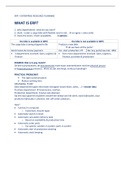Resume
Uitgebreide samenvatting ERP! 1ste examenkans geslaagd!
- Cours
- Operational Excellence
- Établissement
- Arteveldehogeschool (Artevelde)
Uitgebreide samenvatting ERP Geslaagd bij eerste examenkans. Alleen geleerd uit deze samenvatting! lessen + notities
[Montrer plus]



